+ Open data
Open data
- Basic information
Basic information
| Entry | Database: PDB / ID: 1ezr | ||||||
|---|---|---|---|---|---|---|---|
| Title | CRYSTAL STRUCTURE OF NUCLEOSIDE HYDROLASE FROM LEISHMANIA MAJOR | ||||||
 Components Components | NUCLEOSIDE HYDROLASE | ||||||
 Keywords Keywords | HYDROLASE / alpha/beta fold | ||||||
| Function / homology |  Function and homology information Function and homology informationinosine nucleosidase / inosine nucleosidase activity / uridine nucleosidase / uridine nucleosidase activity / purine nucleosidase activity / purine-containing compound salvage / nucleotide metabolic process / calcium ion binding Similarity search - Function | ||||||
| Biological species |  Leishmania major (eukaryote) Leishmania major (eukaryote) | ||||||
| Method |  X-RAY DIFFRACTION / Resolution: 2.5 Å X-RAY DIFFRACTION / Resolution: 2.5 Å | ||||||
 Authors Authors | Shi, W. / Schramm, V.L. / Almo, S.C. | ||||||
 Citation Citation |  Journal: J.Biol.Chem. / Year: 1999 Journal: J.Biol.Chem. / Year: 1999Title: Nucleoside hydrolase from Leishmania major. Cloning, expression, catalytic properties, transition state inhibitors, and the 2.5-a crystal structure. Authors: Shi, W. / Schramm, V.L. / Almo, S.C. | ||||||
| History |
|
- Structure visualization
Structure visualization
| Structure viewer | Molecule:  Molmil Molmil Jmol/JSmol Jmol/JSmol |
|---|
- Downloads & links
Downloads & links
- Download
Download
| PDBx/mmCIF format |  1ezr.cif.gz 1ezr.cif.gz | 238.9 KB | Display |  PDBx/mmCIF format PDBx/mmCIF format |
|---|---|---|---|---|
| PDB format |  pdb1ezr.ent.gz pdb1ezr.ent.gz | 193.4 KB | Display |  PDB format PDB format |
| PDBx/mmJSON format |  1ezr.json.gz 1ezr.json.gz | Tree view |  PDBx/mmJSON format PDBx/mmJSON format | |
| Others |  Other downloads Other downloads |
-Validation report
| Summary document |  1ezr_validation.pdf.gz 1ezr_validation.pdf.gz | 396.1 KB | Display |  wwPDB validaton report wwPDB validaton report |
|---|---|---|---|---|
| Full document |  1ezr_full_validation.pdf.gz 1ezr_full_validation.pdf.gz | 435.7 KB | Display | |
| Data in XML |  1ezr_validation.xml.gz 1ezr_validation.xml.gz | 28.3 KB | Display | |
| Data in CIF |  1ezr_validation.cif.gz 1ezr_validation.cif.gz | 42.2 KB | Display | |
| Arichive directory |  https://data.pdbj.org/pub/pdb/validation_reports/ez/1ezr https://data.pdbj.org/pub/pdb/validation_reports/ez/1ezr ftp://data.pdbj.org/pub/pdb/validation_reports/ez/1ezr ftp://data.pdbj.org/pub/pdb/validation_reports/ez/1ezr | HTTPS FTP |
-Related structure data
| Similar structure data |
|---|
- Links
Links
- Assembly
Assembly
| Deposited unit | 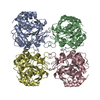
| ||||||||
|---|---|---|---|---|---|---|---|---|---|
| 1 |
| ||||||||
| Unit cell |
| ||||||||
| Details | The biological assembly is a tetramer in the asymmetric unit. |
- Components
Components
| #1: Protein | Mass: 34306.625 Da / Num. of mol.: 4 Source method: isolated from a genetically manipulated source Source: (gene. exp.)  Leishmania major (eukaryote) / Plasmid: PMW172 / Production host: Leishmania major (eukaryote) / Plasmid: PMW172 / Production host:  #2: Chemical | ChemComp-CA / #3: Water | ChemComp-HOH / | |
|---|
-Experimental details
-Experiment
| Experiment | Method:  X-RAY DIFFRACTION / Number of used crystals: 1 X-RAY DIFFRACTION / Number of used crystals: 1 |
|---|
- Sample preparation
Sample preparation
| Crystal | Density Matthews: 2.59 Å3/Da / Density % sol: 52.5 % | ||||||||||||||||||||
|---|---|---|---|---|---|---|---|---|---|---|---|---|---|---|---|---|---|---|---|---|---|
| Crystal grow | Temperature: 296 K / Method: vapor diffusion, hanging drop / pH: 6.5 Details: PEG 4000, pH 6.5, VAPOR DIFFUSION, HANGING DROP, temperature 296K | ||||||||||||||||||||
| Crystal | *PLUS Density % sol: 56 % | ||||||||||||||||||||
| Crystal grow | *PLUS Temperature: 18 ℃ | ||||||||||||||||||||
| Components of the solutions | *PLUS
|
-Data collection
| Diffraction | Mean temperature: 296 K |
|---|---|
| Diffraction source | Source:  ROTATING ANODE / Type: RIGAKU / Wavelength: 1.54 ROTATING ANODE / Type: RIGAKU / Wavelength: 1.54 |
| Detector | Type: SIEMENS / Detector: AREA DETECTOR / Date: Aug 1, 1997 |
| Radiation | Protocol: SINGLE WAVELENGTH / Monochromatic (M) / Laue (L): M / Scattering type: x-ray |
| Radiation wavelength | Wavelength: 1.54 Å / Relative weight: 1 |
| Reflection | Resolution: 2.5→99 Å / Num. all: 41035 / Num. obs: 41035 / % possible obs: 84.1 % / Observed criterion σ(F): 0 / Observed criterion σ(I): 0 / Redundancy: 2.45 % / Rmerge(I) obs: 0.072 / Net I/σ(I): 10.5 |
| Reflection shell | Resolution: 2.5→2.59 Å / Redundancy: 1.84 % / Rmerge(I) obs: 0.306 / Num. unique all: 3273 / % possible all: 67.7 |
| Reflection | *PLUS Lowest resolution: 20 Å / Num. measured all: 113835 |
- Processing
Processing
| Software |
| |||||||||||||||||||||||||
|---|---|---|---|---|---|---|---|---|---|---|---|---|---|---|---|---|---|---|---|---|---|---|---|---|---|---|
| Refinement | Resolution: 2.5→20 Å / σ(F): 2 / σ(I): 1.4 / Stereochemistry target values: Engh & Huber
| |||||||||||||||||||||||||
| Refinement step | Cycle: LAST / Resolution: 2.5→20 Å
| |||||||||||||||||||||||||
| Refine LS restraints |
| |||||||||||||||||||||||||
| Software | *PLUS Name:  X-PLOR / Version: 3.843 / Classification: refinement X-PLOR / Version: 3.843 / Classification: refinement | |||||||||||||||||||||||||
| Refinement | *PLUS Lowest resolution: 20 Å / σ(F): 2 | |||||||||||||||||||||||||
| Solvent computation | *PLUS | |||||||||||||||||||||||||
| Displacement parameters | *PLUS Biso mean: 37.4 Å2 | |||||||||||||||||||||||||
| Refine LS restraints | *PLUS
|
 Movie
Movie Controller
Controller



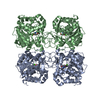

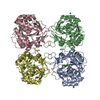
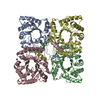

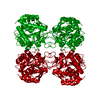
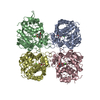

 PDBj
PDBj


